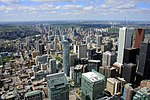Minto Midtown

The Minto Midtown is a residential complex on Yonge Street in Toronto in the Davisville neighbourhood near Yonge and Eglinton consisting of two towers, Quantum (37 storeys) and Quantum 2 (52 storeys) developed by Minto Developments Inc. The proposed project—which substantially exceeded existing height and zoning limits—was met with substantial neighborhood and city opposition, until Minto appealed to the Ontario Municipal Board and worked out a deal with the City of Toronto. Quantum is 37 storeys (413 ft) and was completed in 2007. Quantum 2 is 52 storeys (541 ft) and was completed in 2008. The initial conceptual design was done by Skidmore, Owings & Merrill; Zeidler Partnership Architects developed the design and completed the project.
Excerpt from the Wikipedia article Minto Midtown (License: CC BY-SA 3.0, Authors, Images).Minto Midtown
Anne Johnston Courtyard, Old Toronto
Geographical coordinates (GPS) Address Nearby Places Show on map
Geographical coordinates (GPS)
| Latitude | Longitude |
|---|---|
| N 43.705454 ° | E -79.397593 ° |
Address
PI CO. Pizza Bar
Anne Johnston Courtyard
M4S 2B2 Old Toronto
Ontario, Canada
Open on Google Maps








